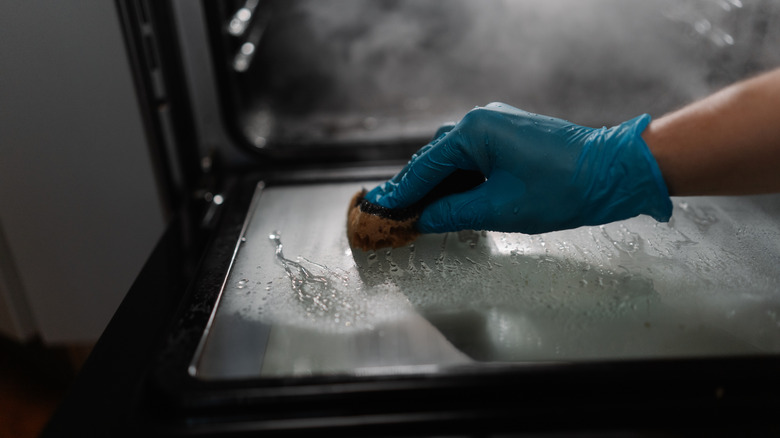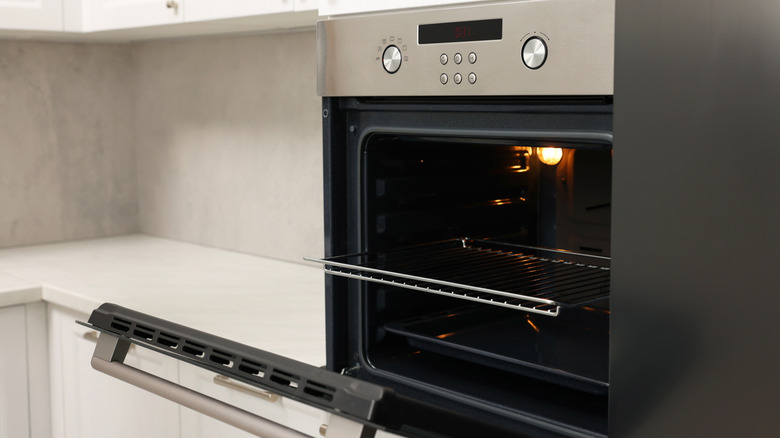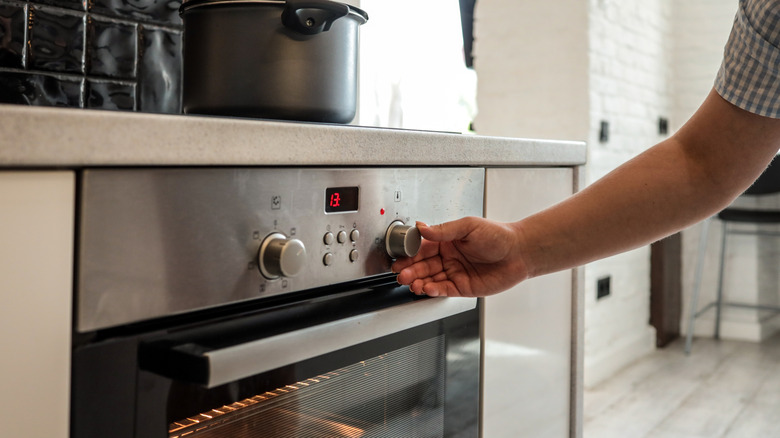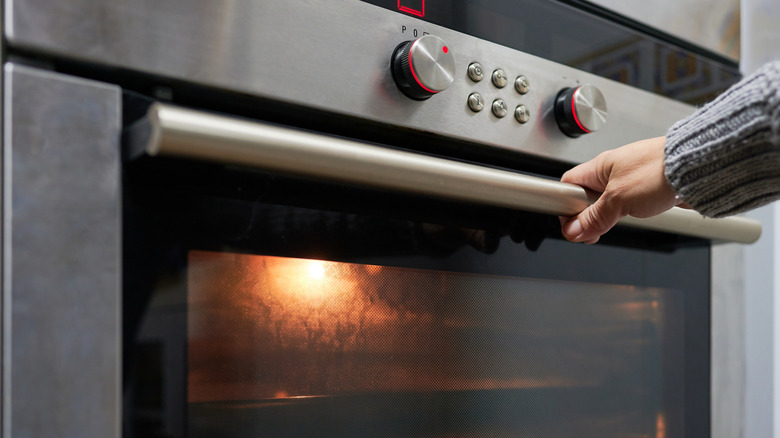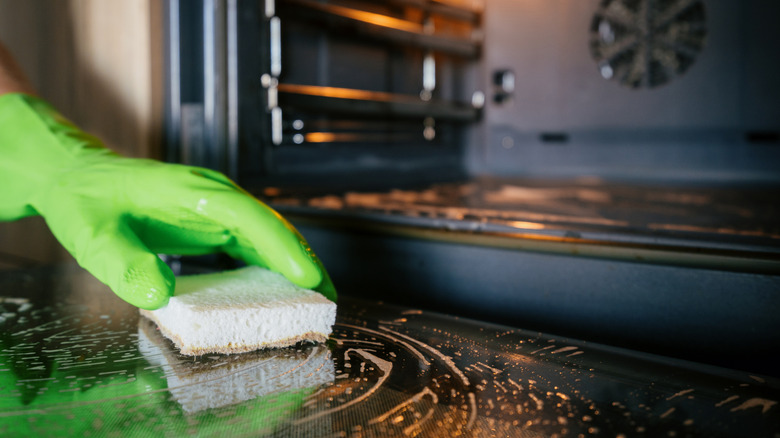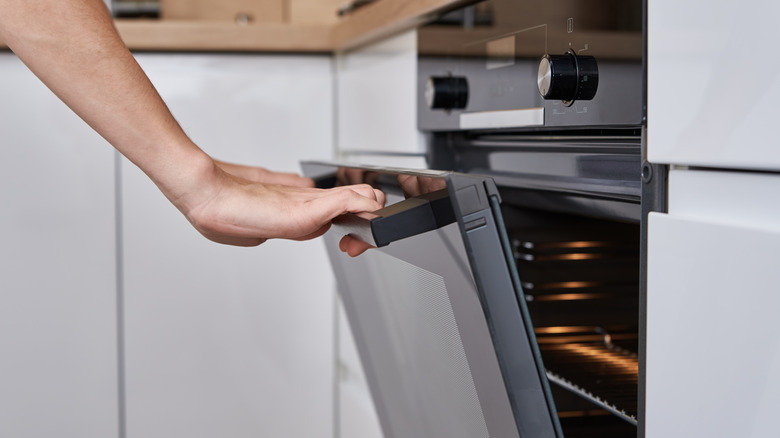7 Mistakes That Everyone Makes When Steam Cleaning An Oven
It's recommended to deep clean your oven at least once a quarter. However, some of the avid home cooks out there may find that a deep clean is needed more often to fight off grime and debris. Whether once every three months fits perfectly into your routine or a monthly wipe down keeps your oven in tip-top condition, you may find yourself turning to steam cleaning to maintain your oven.
Steam cleaning is the process of heating water and using the resulting steam to soften any lingering stubborn messes in your oven for an easier clean. As the steam slowly escapes from the water, it can rehydrate and loosen any baked-on food spills. While some grime may remain, this takes away some of the hassle from scrubbing your oven, making cleaning an easier and more accessible task in your kitchen. Overall, depending on the exact steps you follow and your oven, this oven cleaning hack can be a quick, energy efficient, and effective way to tackle the baked-on remains of old food.
However, the effectiveness of steam cleaning depends on how you do it. While the process is simple, there are small mistakes that can take away from how well this method is able to clean your oven. For example, a seemingly harmless mistake, like using the wrong type of water, can lead to a bigger mess than you started with. Here are the common mistakes to avoid when steam cleaning an oven for the best results.
Not using your oven's included steam function
When it comes to steam cleaning your oven, one of the easiest mistakes to make is not using your oven's built-in steaming function. While not all ovens have this feature, those that do work by simply adding water to a designated spot, selecting the right setting, and letting your oven work its magic. It's important to keep in mind that steam cleaning is not the same as self cleaning. Always check your manufacturer's guide to see if steam cleaning is available with your oven and the correct way to use this feature.
Using too low of a temperature
Temperature plays a big role in how well this method will work for cleaning your oven. Although water boils as low as 212 degrees Fahrenheit, you'll want to set your oven higher: around 450 degrees. Using this higher temperature can make the steaming process more effective, which means less scrubbing and scraping for you later on. Of course, just like when you're baking something in your oven, you'll want to be wary of the heat when interacting with your oven at this time — especially when it comes to adding or removing your water dish.
Not waiting for your oven to preheat
Using a temperature that's too low is only one common heat-related problem you may encounter when steam cleaning your oven. It's also important to wait for your oven to fully preheat before adding your dish of water. Because water will boil and produce steam before your oven reaches the optimal cleaning temperature, waiting until the preheating process is finished will give you the right level of steam production.
Not wiping down your oven after steam cleaning
Steam cleaning is only part of the process when it comes to that sparkling clean result. After you steam your oven and remove your dish, you still need to wipe down the inside of your oven to remove the now-softened debris. You can do this with a warm, damp rag. If you have tougher grime, you may want to use one of the various natural ways to clean your oven, such as using a baking soda paste, for extra scrubbing power.
Forgetting to let your oven cool
Before wiping down your oven, however, it's important to avoid this common mistake: not letting your oven cool after steaming. While you don't want your oven to grow cold, which can lead to any baked-on food re-hardening, it does need to be safe enough to clean by hand. Once you've finished steaming your oven, leave the door shut and set a timer for 45 minutes to an hour, then check the temperature. This also gives the steam time to soften any burnt bits.
Using the wrong type of water
While cleaning an oven with a steaming feature is as simple as adding water and pressing a button, not all types of water are equally cut out for this job. If you live in an area with hard water, using tap water can cause mineral deposits to show up after you clean. As a result, consider using a filtered or distilled water option instead, whether using a self-steaming oven or a DIY alternative. This steam clean water rule also applies to cleaning other areas of your home, like windows you want to leave spotless.
Not using enough water
Have you ever tried steam cleaning your oven, just to open the door and find your favorite dish cracked? If so, this is likely because you didn't use enough water. Not using enough water is one of the most common mistakes people make when cleaning an oven. Without the right amount, evaporation can quickly leave your dish dry, which can cause cracking or breaking. It can also reduce the effectiveness of your steam cleaning. As a result, consider how long you plan on leaving your oven to steam and choose an appropriate amount of water.
